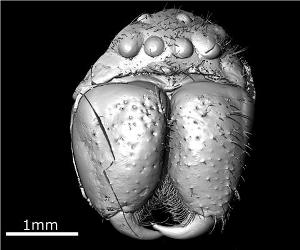Researchers at Manchester University, in collaboration with their German counterparts, have obtained elaborate three-dimensional images of a 49-million–year-old spider trapped in an opaque portion of an amber resin fossil.
The images were captured with the help of X-ray computed tomography, which helped study the age-old spider that was hardly visible under the microscope.
 The 49 million-year-old Huntsman spider seen using X-ray computed tomography
The 49 million-year-old Huntsman spider seen using X-ray computed tomography
An account about this discovery has been published in the Naturwissenschaften, an international journal, which reveals that the fossil preserved in the Natural History Museum in Berlin is a member of Huntsman spiders (Sparassidae), a group of lively spiders that generally do not get caught in amber.
The scientists have made a short film showing stunning details of the oldest spider of the huntsman genus, establishing the fact that even samples in ancient amber pieces, which look insignificant at first sight, can provide important data when analyzed using computed tomography.
According to Dr David Penney of the Faculty of Life Sciences in Manchester University, this spider belongs to a collection of fossilized spiders by George Karl Berendt, which is maintained in the Berlin museum . As the ancient amber underwent oxidation over the years and was dark and cracked, scientists endeavored to prove that this is truly a huntsman spider as these spiders are agile and strong and rarely get caught in tree resin. He added that the results obtained established the fact that the spider is a member of a living genus, Eusparassus, which lives in tropical and arid areas of southern Europe, but thrived in Central Europe 50 million years back.
Dr Penney stated that the research is a breakthrough in the field of imaging technology since computed tomography captures 3D stills and videos of extraordinary quality, which helps in the study of important historical samples of fossilized amber and compare them to their living counterparts.